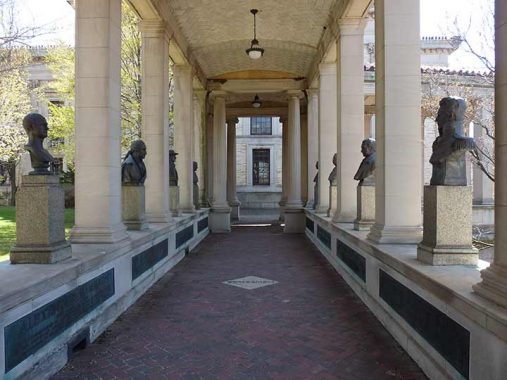
THE Bronx’ very own Hall of Fame predates the sports halls of fame in Cooperstown, NY, Canton, OH and Springfield, MA. There are halls of fame for rock and roll, cowgirls, country music, robots, clowns, therapists, snowmobiling, and thousands of others. A Google search for the phrase “hall of fame” lists the Rock & Roll Museum in Cleveland as its Number One item; and while Google finds nearly 8 million mentions of the phrase “hall of fame” on the internet, none of its first ten pages of findings mention The Hall of Fame for Great Americans. Yet, it’s the model for all the Halls that followed it.
The original Hall was the brainchild of Henry M. MacCracken, President of New York University in 1901. He would place a classical arcade on one of the highest points in the Bronx, from which there are spectacular views of Manhattan and beyond, the palisades of New Jersey. He would honor great Americans in the fields of government, science and the arts, and would hire the renowned architect Stanford White to build a tribute to the great men (and a few women) and call it the Hall Of Fame for Great Americans; people would come to this great hall from miles around.
MacCracken built the NYU campus beginning in 1894 on a bluff overlooking the Harlem River, purchasing an estate in what was then open country. The complex includes the domed Gould Memorial Library, Baker Hall of Philosophy and Hall of Languages, all New York City landmarks. The Hall of Fame, a 630-foot semicircular classical colonnade, juts out over the highest elevation in the Bronx.
A group of 100 electors culled from the ranks of university presidents, historians, journalists and educators nominated and voted for Hall of Fame admission every five years, later changed to every three. Qualifications for admission included US citizenship, and nominees were required to be deceased for 25 years. The original 29 inductees included George Washington, with the last bust installed to date being Franklin D. Roosevelt in 1992. In 2016, two busts, Generals Stonewall Jackson and Robert E. Lee, were removed; as they served as enemy combatants for four years, I’m not complaining too much about it.
Walking the hall you will find busts of 98 of the country’s greatest politicans, scholars, teachers and authors, created by some of the country’s most noted sculptors. Even the name plates under the busts were made by Tiffany Studios. Most of the names familiar from American history books can be found in the Hall, including Abraham Lincoln, Alexander Graham Bell, Samuel Morse, Robert Fulton; both Wright brothers and Thomas Edison are represented. There are several lesser-known figures such as astronomers Simon Newcomb and Maria Mitchell, first American Nobel Prize winner in science Albert Michelson, and anaesthetist William T. Green Morton.
MacCracken conceived the Hall of Fame as a major tourist attraction and for much of the 20th Century his dream was realized. Circle Line boats would slow or stop in the Harlem River below the colonnade; patriotic music would play, and the narrator would intone the exploits of many of the hall’s burgeoning number of inductees. These days, however, the Hall, unfortunately, seems never to be crowded.
The Hall began to deteriorate after NYU moved out of the campus and the Bronx Community College moved in back in 1976. The bronzes, which have been cited by the National Society of Sculptors to be “the most significant collection of bronzes in the country” suffered from the effects of acid rain and the colonnade supports were crumbling. Fortunately, funds were found to rehabilitate and restore the Hall between 1980 and 1985. However, four inductees are on hold until funds can be found for the $25,000 apiece each bust will require.
Usually the Hall of Fame is open seven days a week from 10am to 5pm. Enter the Bronx Community College campus at the gate on Hall of Fame Terrace just past Loring Place North. One thing I would say: go on an overcast day or one with a high overcast, as the curving corridors present a challenge with shadows interfering with good shots on bright, sunny days. In 2023, the Hall was closed for renovations, but is supposed to open by November; we’ll see. I’d like to get up there again, as this photo was taken during my last previous visit in 2016.
As always, “comment…as you see fit.” I earn a small payment when you click on any ad on the site. Take a look at the new JOBS link in the red toolbar at the top of the page on the desktop version, as I also get a small payment when you view a job via that link.
10/18/23
